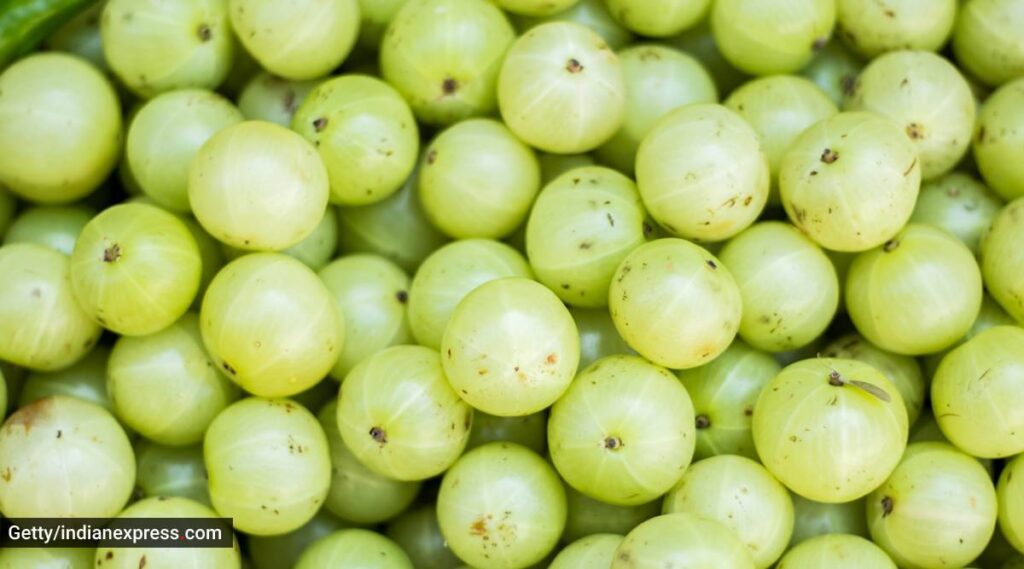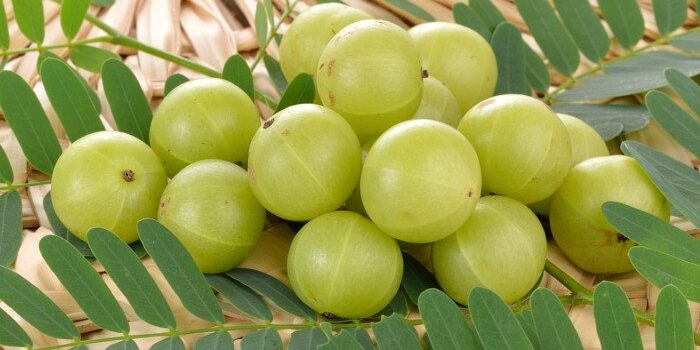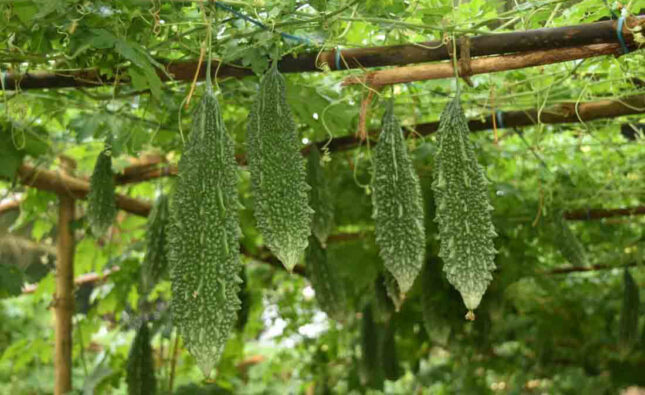Cultivation Of Aonla, Its Health Benefits & Economic Importance for Increasing Livelihood
Aonla, also known as Indian gooseberry or Amalaki, is a fruit native to the Indian subcontinent and widely cultivated in various parts of Asia. It has been used in traditional Ayurvedic medicine for thousands of years due to its numerous health benefits. The scientific name of Aonla is Emblica officinalis. Aonla is a small, round fruit with a light greenish-yellow color.
It has a sour and astringent taste. It is rich in vitamin C, antioxidants, and various other nutrients. The fruit is known for its medicinal properties and is used in various forms such as fresh, dried, or in the form of juice or powder.
Cultivation Of Aonla
The cultivation of Aonla, or Indian gooseberry, is primarily done in tropical and subtropical regions, particularly in India and other parts of Asia. Here are some key aspects of Aonla cultivation:
-
Climate:
Aonla trees thrive in hot and dry climates. They can tolerate temperatures ranging from 0°C to 46°C (32°F to 115°F). However, the ideal temperature range for optimum growth is between 20°C and 38°C (68°F and 100°F).
2. Soil:
Aonla can grow in a variety of soils but prefers well-drained sandy loam or loamy soil. The soil pH should be slightly acidic to neutral, ranging from 6.5 to 7.5. Good drainage is crucial to prevent waterlogging, as excess moisture can be detrimental to the plant’s health.
3. Propagation:
Aonla is typically propagated through seeds, grafting, or budding. Seeds are sown in nursery beds, and the resulting seedlings are transplanted to the main field after 6 to 8 months. Grafting or budding methods are used to propagate selected varieties with desirable traits.
4. Planting:
The planting of Aonla trees is usually done during the monsoon season when the soil is moist. Spacing between plants should be around 6 to 8 meters (20 to 26 feet) to allow sufficient growth and airflow. It’s common to have intercropping with crops like legumes or vegetables during the initial years to utilize the land effectively.
5. Irrigation:
Adequate irrigation is crucial, especially during the initial years after planting. Young trees require regular watering to establish their root systems. Once the trees are established, Aonla can tolerate some degree of drought but responds well to regular watering during dry periods.
6. Pruning and Training:
Pruning helps maintain the shape of the tree and promotes better light penetration and air circulation. It is typically done during the dormant season to remove dead or diseased branches and to shape the tree for optimal fruit production.
7. Fertilization:
Aonla trees respond well to balanced fertilization. Organic manure and compost can be applied before planting, and regular applications of nitrogen, phosphorus, and potassium fertilizers are recommended. The specific fertilizer requirements may vary depending on the soil conditions and the tree’s age.
8. Pest and Disease Management:
Common pests that affect Aonla include fruit borers, leaf-eating caterpillars, and aphids. Proper monitoring and timely application of organic or chemical insecticides can help control these pests. Diseases such as powdery mildew, fruit rot, and leaf spot can also occur, and appropriate fungicides should be used as per the guidance of agricultural experts.
9. Harvesting:
Aonla trees typically start bearing fruit after 3 to 4 years of planting. The fruits are harvested when they attain their full size, but before they start to soften. The harvesting period usually occurs from December to March, depending on the region. Aonla cultivation requires proper care, management, and knowledge of local growing conditions. Local agricultural authorities or experts can provide specific guidance based on the region and prevailing conditions.
Varieties
The varieties recommended for cultivation are Banarasi, Chakaiya, Francis, NA-4 (Krishna), NA 5 (Kanchan), NA-6, NA-7, NA-10 and BSR-1 (Bhavanisagar).
Aonla Ingredient
Aonla, or Indian gooseberry, contains various beneficial ingredients that contribute to its nutritional and medicinal properties. Here are some key ingredients found in Aonla:
-
Vitamin C:
Aonla is one of the richest natural sources of vitamin C (ascorbic acid). It contains significantly higher levels of vitamin C compared to other fruits, making it an excellent immune booster and antioxidant.
2. Polyphenols:
Aonla is rich in polyphenolic compounds such as gallic acid, ellagic acid, and tannins. These polyphenols have antioxidant, anti-inflammatory, and anticancer properties.
3. Flavonoids:
Aonla contains flavonoids like quercetin, kaempferol, and rutin. Flavonoids are potent antioxidants that help protect the body against oxidative stress and inflammation.
4. Minerals:
Aonla contains various minerals such as calcium, phosphorus, iron, and potassium, which are essential for maintaining overall health and proper functioning of the body.
5. Fiber:
Aonla is a good source of dietary fiber, which aids in digestion, promotes bowel regularity, and helps control blood sugar levels.
6. Carbohydrates:
Aonla contains carbohydrates, including simple sugars like fructose and glucose, which provide energy to the body.
7. Essential amino acids:
Aonla contains several essential amino acids that are required for protein synthesis and various metabolic processes in the body.
8. Lipids:
Aonla contains small amounts of lipids (fats), including fatty acids such as linoleic acid and oleic acid.
9. Water:
Aonla has a high water content, which contributes to its juiciness and hydrating properties. These ingredients contribute to the nutritional value and potential health benefits of Aonla. However, it’s important to note that the composition and concentration of these ingredients may vary depending on factors such as the variety of Aonla, ripeness, and growing conditions.
Health Benefits of Aonla
Aonla, or Indian gooseberry, offers a range of health benefits due to its rich nutritional profile. Here are some potential health benefits associated with Aonla consumption:
-
Boosts immune system:
Aonla is renowned for its high vitamin C content, which strengthens the immune system and helps fight off infections. It enhances the production of white blood cells and antibodies, promoting overall immunity.
2. Antioxidant properties:
Aonla is packed with antioxidants like vitamin C, polyphenols, and flavonoids. These compounds help neutralize harmful free radicals, reducing oxidative stress and the risk of chronic diseases such as heart disease, cancer, and neurodegenerative disorders.
3. Improves digestion:
Aonla contains dietary fiber, which aids in proper digestion and prevents constipation. It helps regulate bowel movements and promotes a healthy digestive system.
4. Enhances nutrient absorption:
The presence of tannins in Aonla helps improve the absorption of nutrients from food, ensuring that the body effectively utilizes essential vitamins, minerals, and other nutrients.
5. Supports heart health:
Aonla may help maintain a healthy heart. It helps reduce bad cholesterol (LDL) levels, prevents the oxidation of cholesterol, and improves blood circulation, thereby reducing the risk of heart disease.
6. Regulates blood sugar levels:
Aonla has a low glycemic index and may help regulate blood sugar levels. It promotes insulin secretion, enhances glucose uptake by cells, and improves insulin sensitivity, making it beneficial for individuals with diabetes.
7. Supports liver health:
Aonla exhibits hepatoprotective properties, protecting the liver from damage caused by toxins and free radicals. It aids in detoxification, promotes liver function, and may help prevent liver diseases.
8. Anti-inflammatory effects:
Aonla possesses anti-inflammatory properties, which can help reduce inflammation in the body. It may provide relief from inflammatory conditions such as arthritis, asthma, and inflammatory bowel diseases.
9. Improves skin and hair health:
The antioxidants and vitamin C in Aonla help combat skin aging by neutralizing free radicals, promoting collagen synthesis, and maintaining skin elasticity. It also strengthens hair follicles, reduces hair fall, and improves hair texture and shine.
10. Enhances cognitive function:
Aonla may have a positive impact on brain health. It helps improve memory, concentration, and cognitive function. The antioxidants in Aonla protect brain cells from oxidative damage and may potentially reduce the risk of age-related cognitive decline. It’s worth noting that while Aonla offers potential health benefits, individual results may vary, and it should not replace medical advice or treatment. If you have specific health concerns, it’s advisable to consult with a healthcare professional before incorporating Aonla or any other dietary changes into your routine.

Economic Importance of Aonla
Aonla, or Indian gooseberry, holds significant economic importance in various aspects. Here are some key economic contributions of Aonla:
-
Agricultural industry:
Aonla cultivation provides income and livelihood opportunities for farmers. It is a commercially viable crop, especially in India and other parts of Asia. Farmers engage in Aonla cultivation to meet the demand for fresh fruits, processed products, and medicinal preparations.
2. Export potential:
Aonla has export potential due to its nutritional value and medicinal properties. It is exported in various forms, including dried fruits, juice concentrates, powders, and herbal supplements. This generates foreign exchange earnings for the countries involved in its cultivation and export.
3. Food industry:
Aonla is used as a raw material in the food industry for the production of various products. The fruits are processed into jams, jellies, chutneys, pickles, candies, and beverages. Aonla-based products are consumed locally and also exported, contributing to the revenue of food processing companies.
4. Ayurvedic and herbal medicine:
Aonla has been used in traditional Ayurvedic medicine for its therapeutic properties. It is a key ingredient in many Ayurvedic formulations and herbal remedies. The demand for Aonla-based Ayurvedic medicines and supplements creates a market for its cultivation and processing.
5. Nutraceutical and pharmaceutical industries:
Aonla extracts and supplements are utilized by the nutraceutical and pharmaceutical industries. Extracts are used in the production of dietary supplements, herbal capsules, and health products. The demand for natural and herbal remedies has increased, leading to the inclusion of Aonla in various formulations.
6. Cosmetics and personal care products:
Aonla extracts and oils are utilized in the cosmetics and personal care industry. They are incorporated into skincare products, hair care products, and herbal cosmetics due to their antioxidant and nourishing properties.
7. Employment generation:
Aonla cultivation and processing create employment opportunities along the value chain. This includes activities such as farming, harvesting, processing, packaging, transportation, marketing, and sales. Aonla-based industries provide jobs to farmers, laborers, technicians, and professionals.
8. Rural development:
Aonla cultivation can contribute to rural development, particularly in areas where it is grown. It provides an alternative crop option for farmers and helps diversify agricultural practices. This can lead to improved income, livelihoods, and socio-economic conditions in rural communities.
9. Research and development:
Aonla continues to be a subject of research and development in the fields of agriculture, food science, and medicine. Studies focus on improving cultivation techniques, developing new varieties, exploring novel applications, and uncovering additional health benefits. This research contributes to scientific knowledge and innovation. Overall, the economic importance of Aonla lies in its contribution to agriculture, food industry, exports, traditional medicine, pharmaceuticals, cosmetics, and rural development. Its cultivation and utilization generate income, employment, and business opportunities while promoting sustainable agriculture and natural product-based industries.
Diseases & Its Control in Aonla
Aonla, like any other plant, is susceptible to various diseases that can affect its growth and productivity. Here are some common diseases that can affect Aonla and measures for their control:
-
Collar Rot (Phytophthora spp.):
Collar rot affects the base of the tree, causing rotting of the collar region and subsequent wilting and death of the plant. To control collar rot, maintain proper drainage to prevent waterlogging, avoid excessive irrigation, and ensure proper spacing between trees for good airflow. Application of fungicides and soil drenching with fungicidal solutions can help manage the disease.
2. Fruit Rot (Colletotrichum gloeosporioides):
Fruit rot causes brown spots on the fruits, leading to their decay and loss. To control fruit rot, ensure proper sanitation and remove infected fruits. Fungicidal sprays, especially before and after flowering, can help manage the disease. Good orchard hygiene, including the removal of fallen leaves and fruit debris, is also essential.
3. Leaf Spot (Cercospora spp., Alternaria spp.):
Leaf spot appears as circular or irregular spots on the leaves, which can turn brown or black over time. To control leaf spot, practice good orchard sanitation, remove infected leaves, and provide proper spacing between trees for good air circulation. Fungicidal sprays containing copper-based or systemic fungicides can be used as recommended.
4. Powdery Mildew (Erysiphe spp., Oidium spp.):
Powdery mildew appears as a white powdery growth on the leaves, shoots, and fruits. It can affect the plant’s growth and yield. To control powdery mildew, ensure proper sunlight penetration, avoid excessive nitrogen fertilization, and maintain optimal humidity levels. Fungicidal sprays containing sulfur or systemic fungicides can help manage the disease.
5. Dieback (Botryodiplodia theobromae):
Dieback causes the drying and wilting of branches and shoots, leading to the decline of the tree. To control dieback, prune and remove infected branches, maintain proper orchard hygiene, and avoid injuries during pruning. Application of copper-based fungicides on pruning wounds can help prevent fungal infection.
6. Root Rot (Phytophthora spp., Rhizoctonia spp.):
Root rot affects the roots, leading to stunted growth, wilting, and eventual death of the plant. To control root rot, ensure proper drainage and avoid waterlogging. Use well-drained soil and practice crop rotation. Avoid over-irrigation and use fungicides or biocontrol agents specifically designed for root rot management. It is important to note that the specific management strategies for disease control may vary depending on the local conditions, severity of the disease, and the recommendations of agricultural experts or plant pathologists. Regular monitoring, early detection of diseases, and timely implementation of appropriate control measures are crucial for effectively managing diseases in Aonla orchards. Consulting with local agricultural authorities or seeking guidance from experts is advisable for accurate diagnosis and customized disease management practices.

Sales & Export of Aonla
The sales and export of Aonla, or Indian gooseberry, contribute to the agricultural and international trade sectors. While I don’t have access to real-time data, I can provide you with a general overview of Aonla sales and export trends based on historical information:
-
Domestic Sales:
Aonla has a significant domestic market, especially in India. Fresh Aonla fruits are sold in local markets and grocery stores, particularly during the harvesting season. Processed Aonla products such as pickles, candies, juices, and powders are also widely available and consumed within the country.
2. Export Markets:
Aonla has export potential and is shipped to various countries, primarily in Asia, Europe, North America, and the Middle East. The demand for Aonla-based products varies in different regions, depending on factors such as cultural preferences, diaspora populations, and awareness of its health benefits.
3. Export Products:
Aonla is exported in various forms, including dried fruits, juice concentrates, powders, and extracts. Dried Aonla fruits are popular as a snack or ingredient in traditional medicine preparations. Juice concentrates are used in the beverage industry, while powders and extracts are utilized in dietary supplements, herbal formulations, and cosmetic products.
4. Exporters:
Aonla exports are typically carried out by agricultural and food processing companies, as well as exporters specializing in herbal and Ayurvedic products. These entities work closely with Aonla farmers, processing facilities, and regulatory authorities to ensure compliance with quality standards and international trade regulations.
5. Government Initiatives:
Government bodies in Aonla-producing countries, such as India, may support Aonla exports through promotional campaigns, market research, and trade facilitation. They may provide financial incentives, infrastructure development, and quality certifications to encourage Aonla exports and enhance market access.
6. Export Challenges:
Aonla exports may face challenges related to packaging, shelf life, transportation logistics, and compliance with import regulations of different countries. Ensuring consistent quality, meeting international food safety standards, and establishing strong distribution networks are crucial for sustained export growth. It’s important to note that the sales and export figures of Aonla can vary from year to year due to factors such as crop yield, market demand, pricing, and global trade dynamics. For the most up-to-date and specific information on Aonla sales and export, it would be advisable to refer to industry reports, trade statistics, agricultural authorities, and market research organizations.







